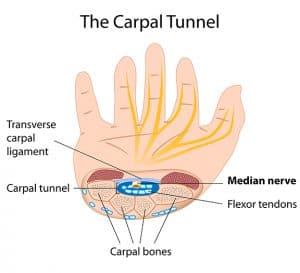What Are Common Carpal Tunnel Syndrome Treatments?
- What is Carpal Tunnel Syndrome?
- What are the Causes and Signs of Carpal Tunnel Syndrome?
- Is Carpal Tunnel Syndrome Caused by Typing?
- How Do You Diagnose Carpal Tunnel Syndrome?
- What is the Treatment for Carpal Tunnel?
Estimated to be currently affecting between four and 10 million Americans, carpal tunnel syndrome is arguably one of the most common nerve disorders diagnosed today according to the American College of Rheumatology. Carpal tunnel syndrome can be treated effectively with medications, splinting, injections and, if all other treatment methodologies fail, surgery.
What is Carpal Tunnel Syndrome?
Carpal tunnel syndrome is a condition in which there is a progressive pain, numbness and eventually weakness in the hand and wrist, caused by increased pressure on the median nerve in the wrist. The carpal tunnel is a narrow space through which nine tendons and one nerve cross the wrist to reach the hand.
“It’s important to note that tendons are not bothered by increased pressure, but the median nerve gets very irritated and will, therefore, cause the discomfort of carpal tunnel syndrome when the pressure goes up in the tunnel,” says Lawrence S. Halperin, M.D., a board-certified orthopaedic surgeon at Orlando Orthopaedic Center sub-specializing in the hand and upper extremities.
What are the Causes and Signs of Carpal Tunnel Syndrome?
There are a variety of factors that can contribute to carpal tunnel syndrome, ranging from nature of one’s work to underlying health problems.
Most people with carpal tunnel syndrome complain of intermittent tingling in the hand. For some, the numbness can be very mild and minimally bothersome. But for others it can be so painful it makes simple tasks such as reading a book, typing on a keyboard or holding a jug of milk difficult and cumbersome. It can cause patients to wake up throughout the night preventing restful sleep.
The diagnosis is most often seen in people who have already reached middle-age. It is much more common in women than men. There is also an increased risk in diabetics, people with rheumatoid arthritis and during pregnancy.
“Many people with carpal tunnel syndrome will have no identifiable cause of the problem. In fact, it can happen for no good reason at all,” says Dr. Halperin. “Many of my patients try to figure out what they’ve done to cause carpal tunnel syndrome, but the simple answer for many of them is just that there is no identifiable cause, and sometimes ‘stuff happens.’”
Is Carpal Tunnel Syndrome Caused by Typing?
You may have heard someone say, “Must be getting Carpal tunnel,” when complaining of a hand numbness after typing. In fact, many people believe their carpal tunnel is a direct result of typing too much. But, there is some disagreement among hand surgeons whether work can cause carpal tunnel syndrome.
“Several years ago there were several medical articles talking about the increased number of carpal tunnel cases in people who type all day, work on assembly lines, play music professionally or use vibrating tools, such as jackhammers,” says Dr. Halperin. “In other words, it was more common in people who stress their hands for hours at a time,” he continues. “My opinion is that carpal tunnel syndrome can be caused by work. I believe that it has been shown that there are many activities that if done for hours a day can irritate the nerve in the carpal tunnel. But just being near a keyboard and doing intermittent typing probably is not a cause of carpal tunnel syndrome.”
How Do You Diagnose Carpal Tunnel Syndrome?
Carpal tunnel syndrome is the most common cause of numbness in the hand, but it is not the only cause. Numbness may be caused by a variety of other factors including herniated discs in the neck, various spinal issues and diabetic neuropathy. If someone has frequent numbness in the hand, it is a good idea to get checked and make sure the cause is identified. The doctor should take a history, listening to the patient so as to understand the complaints. A physical exam will help determine the cause of numbness and tingling.
“Sometimes an electro diagnostic test is needed,” says Dr. Halperin. “The test measures how fast the nerve carries its signal across the carpal tunnel. The nerve will often carry the signal ‘below the speed limit’ in carpal tunnel syndrome.”
If the diagnosis of carpal tunnel syndrome is confirmed, a proper treatment protocol will be developed.
What is the Treatment for Carpal Tunnel?
For most people, the treatment of carpal tunnel syndrome begins when the symptoms are severe enough that they want to be treated. Remember, the symptoms can be so mild as not to be a problem, and they can also debilitate. Since the pain and numbness associated with carpal tunnel syndrome is a result of increased pressure on the nerve, treatments are designed to lower the pressure.
“The most common early treatments include using a splint to keep the wrist in a position that lowers the pressure in the tunnel,” says Dr. Halperin. “We often use anti-inflammatory medicines such as naproxen and steroids to control inflammation as well. If we can get inflammation in the tunnel to go down, we can get the pressure in the tunnel to go down.”
Another option prescribed by some specialists may be steroid injections. Some, but not all, doctors think steroid injection across the ligament into the carpal tunnel can help. “I believe injections only provide temporary relief and cause a lot of pain if the nerve is inadvertently hit. The nerve is very close to the ligament, so it is not a technique I often use.”
 For the people who don’t improve with a splint and medication, it’s time to discuss surgery. As you can see in Figure 1, three sides of the carpal tunnel are bone and the fourth side is the ligament. The operation cuts this ligament and lowers the pressure inside of the tunnel thus taking pressure off the nerve and allowing the nerve to heal.
For the people who don’t improve with a splint and medication, it’s time to discuss surgery. As you can see in Figure 1, three sides of the carpal tunnel are bone and the fourth side is the ligament. The operation cuts this ligament and lowers the pressure inside of the tunnel thus taking pressure off the nerve and allowing the nerve to heal.
“Carpal tunnel surgery only takes about 15 minutes, and fortunately, the nerve almost always heals just fine. However it can take longer to heal in older people, diabetics and those with long-term severe symptoms,” says Dr. Halperin. “Many people report feeling relief from numbness the day of surgery.”
Simple tasks can be done the day of surgery. Typing on a keyboard can start shortly after that, but it can take several weeks until the full activity is tolerated. Not surprisingly, it can take a bit longer to get back to a job that puts a lot of pressure on the palms (such as jackhammer operators or construction workers).
“When I first saw a carpal tunnel surgery in the early 1980s there was a six-inch incision. Today the surgery requires an incision of about an inch or less and has incredibly high success rates,” says Dr. Halperin. “Patients respond very well to surgery, and they are usually very pleased with the results. Helping someone get back to work or to the activities they enjoy is one of the most rewarding parts of my job.”



